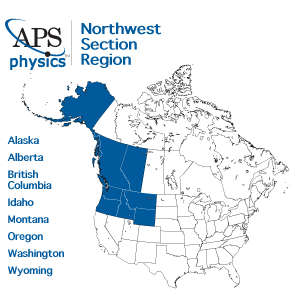
June 2022 (Volume 31, number 6)
From Great Plains to Alaska, Physicists in the Northwest Section Prepare for June Meeting in Canada
By Abigail Dove
Stretching across the northwestern edge of the continent, the Northwest Section (NWS) is a hub for 1,200 APS members in Washington, Oregon, Idaho, Montana, Wyoming, Alaska, and western Canada.
Geographical sections are important to APS. They help APS diffuse the knowledge of physics at a regional level, and they let physicists connect in their own neighborhoods. They can also foster connections between nearby laboratories, companies, and schools, from small liberal arts colleges to large research universities.
Established in 1998, NWS is by far the largest of APS’s 10 geographical sections in terms of land area, covering three time zones and almost two million square miles from the Great Plains to the Pacific Northwest to Alaska. It’s also the only geographical section that extends internationally, with members in the Canadian provinces of Alberta and British Colombia.

Fittingly for such a vast region, the section spans a wide range of physics research. One of the largest universities in the region, the University of Washington, has robust programs in nuclear physics and high energy physics. Meanwhile, smaller colleges in the Northwest boast a rich tradition of atomic, molecular, and optics physics research; optics research in particular is popular in undergraduate classes. The region is also home to TRIUMF, Canada’s premier particle accelerator, located in Vancouver.
As is typical for APS geographical sections, most of NWS’s activity centers on its annual meeting. Each meeting typically draws 100 to 150 participants and features a slate of talks by leaders in different fields, along with presentations and a poster session.
For NWS Chair Andrew Dawes, a professor at Pacific University in Oregon, the NWS Annual Meeting has personal significance: It was the first physics conference he ever attended as an undergraduate. He described the NWS Annual Meeting as an excellent way to hear updates from a broad range of physics fields and compare notes with other researchers in the region.
“I’ve discovered a lot of great connections that I wouldn’t have necessarily made at bigger meetings,” he explained. “As a professor at a smaller college, it is so valuable to see what’s happening at similarly sized and scaled institutions. The NWS Annual Meeting is accessible to smaller institutions, so we can see what types of research work, what types of programs work, and how different departments are thriving and growing.”
The meetings are also accessible to a wider range of people, given the lower costs associated with regional travel. To this end, the executive committee changes the meeting location from year to year, choosing host institutions in different areas in the region to encourage participation.
Still, Dawes acknowledged that traveling to the meetings can be a challenge for many in such a large region, and the executive committee must strike a difficult balance between the main hubs in Seattle, Portland, and Vancouver and smaller hubs in Idaho, Wyoming, Montana, and Alberta.
“On the surface, the sheer size of this section might make things seem slightly less ‘regional,’ but in the northwest, we’re used to things being spread out,” he explained.
NWS’s 2022 Meeting is fast-approaching, scheduled for June 3-5 at Thompson Rivers University in Kamloops, British Columbia—a four-hour drive northeast of Vancouver.
For those on the fence about attending, the meeting location may be a draw. Kamloops is a nature-lover’s dream, with an extensive network of hiking and mountain-biking trails and more than 100 lakes in the area for kayaking and fishing. Kamloops is also home to a thriving scene of local wineries and microbreweries, perfect for after-conference socializing.
The meeting website promises “a breadth of physics presentations, from subatomic to cosmic.” Plenary sessions will cover the latest updates from the TRIUMF particle accelerator, new data from the Canadian Hydrogen Intensity Mapping Experiment (CHIME), and discussions on nuclear astrophysics, low temperature physics, and atomic interferometry. Dawes highlighted an additional session that will bring together physics department chairs from several institutions to discuss ongoing challenges in higher education—namely, demographic change and dips in enrollment from the COVID-19 pandemic.
Students make up more than 30% of NWS’s ranks, and the Annual Meetings are designed to be extremely student-friendly. The meetings enable students to present their research outside their own schools, often for the first time, and the wide range of fields represented at the meetings can help students learn to tailor their talks to a broad audience—a vital skill. Students who attend also get plenty of opportunities for career development. This includes careers outside academia, paths that are often unfamiliar to young scientists.
Overall, NWS stands out as a lively and inclusive geographical section, offering members—especially students—professional development, learning opportunities, and community. Visit the NWS website to learn more.
Abigail Dove is a freelance writer in Stockholm, Sweden.
©1995 - 2024, AMERICAN PHYSICAL SOCIETY
APS encourages the redistribution of the materials included in this newspaper provided that attribution to the source is noted and the materials are not truncated or changed.
Editor: Taryn MacKinney
June 2022 (Volume 31, number 6)
Articles in this Issue
